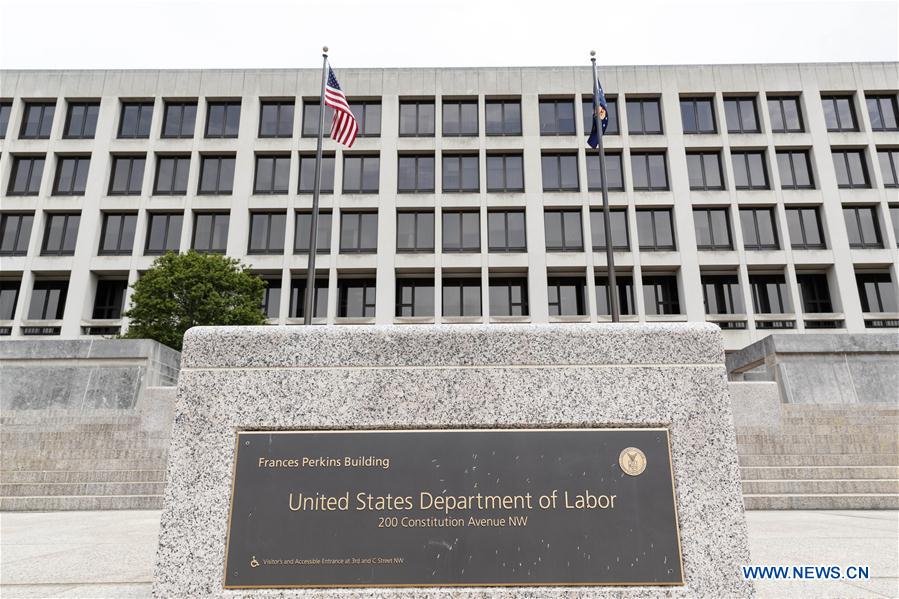
Photo taken on May 8, 2020 shows the building of U.S. Department of Labor in Washington D.C., the United States. U.S. employers cut a staggering 20.5 million jobs in April, and the unemployment rate soared to a record 14.7 percent, as COVID-19 continues to ravage the economy, the U.S. Bureau of Labor Statistics reported Friday. (Photo by Ting Shen/Xinhua)
WASHINGTON, May 8 (Xinhua) -- U.S. employers cut a staggering 20.5 million jobs in April, and the unemployment rate soared to a record 14.7 percent, as COVID-19 continues to ravage the economy, the U.S. Bureau of Labor Statistics reported Friday.
The unemployment rate of 14.7 percent, up by 10.3 percentage points from that in March, is the highest level since the Great Depression. The losses in the single month of April erased a decade of job gains since the global financial crisis.
"Today's devastating jobs report confirms that the labor market is in free fall, undoing years of economic progress," said Shai Akabas, director of economic policy at the Bipartisan Policy Center. "Unfortunately, we already know it gets worse from here."
"Employment fell sharply in all major industry sectors, with particularly heavy job losses in leisure and hospitality," the bureau said, noting that the changes in these measures reflect the effects of the COVID-19 pandemic and efforts to contain it.
In April, employment in leisure and hospitality plummeted by 7.7 million, or 47 percent, the report showed. Almost three-quarters of the decrease, or 5.5 million, occurred in food services and drinking places.
Employment also fell in the arts, entertainment, and recreation industries, by 1.3 million, and dropped in the accommodation industry by 839,000, the report showed.
Education and health services cut 2.5 million jobs in April, while professional and business services shed 2.1 million jobs, according to the report.
Employment in retail trade declined by 2.1 million, the bureau said, while noting that the component of general merchandise stores that includes warehouse clubs and supercenters gained 93,000 jobs.
Manufacturing employment, meanwhile, dropped by 1.3 million, the report showed. About two-thirds of the decline was in durable goods manufacturing, which saw losses in motor vehicles and parts and in fabricated metal products.
Government employment also dropped by 980,000 in April, according to the bureau. Employment in local government was down by 801,000, in part reflecting school closures.
Hispanics and African-Americans have been hit the hardest in the COVID-19-induced job crisis. Data showed that the unemployment rate in April jumped to 18.9 percent for Hispanics, 16.7 percent for African-Americans, 14.5 percent for Asians and 14.2 percent for whites.
The number of unemployed persons who reported being on temporary layoff soared about tenfold to 18.1 million in April, while the number of permanent job losers increased by 544,000 to 2.0 million, according to the report.
The report also showed that the labor force participation rate dropped by 2.5 percentage points over the month to 60.2 percent, the lowest rate since January 1973, when it was 60.0 percent.
"Because of the survey's timing, these data give a snapshot of the labor market from three weeks ago," Akabas said. "Since then, millions more have lost their jobs, as evidenced by the ongoing streak of record-setting unemployment insurance claims."
The new unemployment data came one day after the bureau reported that the number of initial jobless claims totaled nearly 3.2 million last week. The figure reached 3.8 million in the prior week.
So far, the seven-week total has surpassed an unprecedented 33 million, indicating the scope of COVID-19's damage to the U.S. labor market.
The new jobs report also revised down total nonfarm payroll employment for February by 45,000 to an increase of 230,000, and the change for March was also revised down by 169,000 to a loss of 870,000.
In April, average hourly earnings for all employees on private nonfarm payrolls increased by 1.34 U.S. dollars, or 4.7 percent, to 30.01 dollars, the report showed. Average hourly earnings of private-sector production and non-supervisory employees increased by 1.04 dollars, or 4.3 percent, to 25.12 dollars in April.
"The increases in average hourly earnings largely reflect the substantial job loss among lower-paid workers; this change, along with earnings increases, put upward pressure on the average hourly earnings estimates," the bureau said.
Analysts said it could take years to return to the historically low 3.5 percent unemployment rate the country experienced before the COVID-19 outbreak. Since September last year, the unemployment rate had been hovering around 3.5 to 3.6 percent until February.


